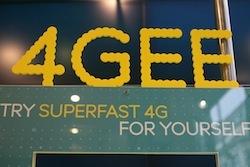At a press briefing announcing that it has reached the 500,000 customer mark for its 4G LTE services, UK operator EE poured scorn onto its competitors’ efforts to roll out the next gen technology and hinted about expanding its network to cover major transport routes.
EE’s director of network integration and LTE Mansoor Hanif said that while EE respects its competition, he had doubts that other operators realise how hard it is to successfully roll out 4G LTE services in the UK.
“Because we went very fast [with our roll out], perhaps they understood that it was really easy, which I think is a bit complacent and a bit strange,” said Hanif.
“I believe that Vodafone and O2 will find it very difficult based on their model of sharing. It’s very difficult to agree on the designs for the transmissions – we fight over all the technical problems. Too many engineers in a room will never agree over everything.”
Keith Groombridge, principal delivery manager for EE agreed: “Although we compete against Three, we share a lot of network infrastructure with them. From an LTE perspective, backhaul is absolutely key to giving a good experience and getting the great speeds we’re seeing, so when it comes to the design work, it’s taken a lot of time and effort for us to reach agreements and find solutions that work for both us and Three.
“If you look at operators around the world when they roll out their LTE network, when they do their design work, very rarely have they had to do that in collaboration with their competitors.”
On top of working together with competitors, Groombridge sees working and coordinating efforts with multitudes of partners as one of the greatest challenges to a successful 4G LTE network roll out.
“We have so many different partners, from managed service providers, transmission providers, equipment providers. We had an army of people, and driving that immense machine takes a tremendous amount of energy, [in order to] get all the organisations focused and aligned, working together towards the same goal,” he said.
In addition, Hanif said that it was important to treat key suppliers right.
“Some of our suppliers in the UK are telling us that Vodafone and O2 are a little bit arrogant in their dealings with them,” Hanif told Mobile Europe. “It’s not how we are. We’re very passionate and we like to be ahead … we’re very keen to get people on board.”
He also raised doubts about Vodafone and O2’s plan to split the UK in half, with each operator handling the 4G LTE network for each side of the country.
“[Vodafone CEO] Vittorio recently said, ‘We will have the only true LTE’, implying that only 4G LTE services running on the 800MHz band are ‘true LTE’,” said Hanif.
“What is ‘true LTE’? I don’t really understand it. I don’t know what you call ‘true LTE’, but to me, I see it as LTE you can touch, use and buy in a shop. It’s not true LTE if you can’t even buy it. I would be embarrassed to announce that something I hadn’t even launched was ‘true’ when something someone else had launched wasn’t ‘true’.
“We’d really like to understand from Vodafone what ‘true LTE’ really is. In this building we measured the indoor coverage speed to be 50Mbps. If that isn’t true LTE, what is?”
EE also indicated a strong interest in expanding its 4G LTE network across major transport routes, from providing better railway train coverage for commuters, as well as working towards connected cars.
“Cars are now mobile femtos, so I’m very keen for us to connect the motorways,” said Hanif.
He cited the example of a car parked in a remote location with a 800 MHz antenna on its roof that could act as a mobile hotspot, transmitting Wi-Fi to the house.
He also indicated that EE was looking into forming strategic partnerships with rail partners in order to provide coverage on the rail networks.


